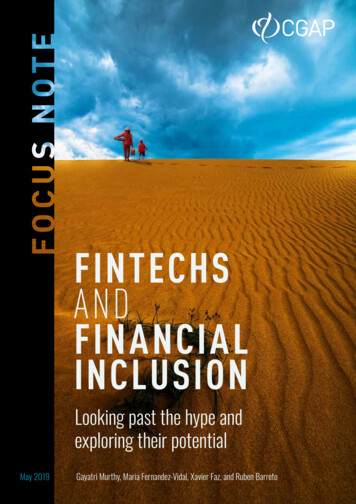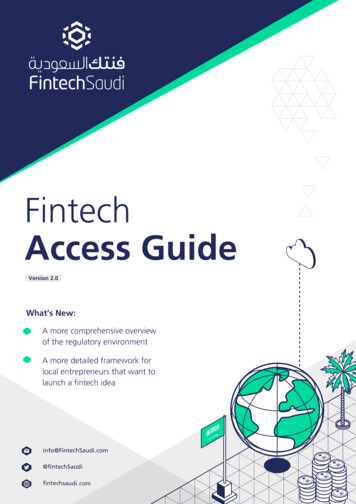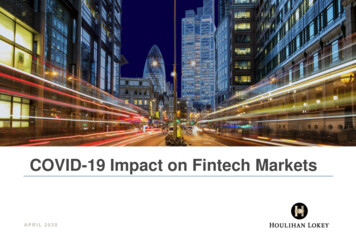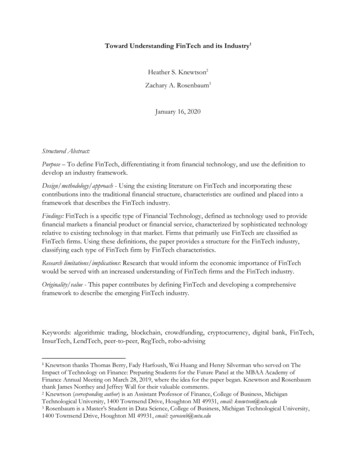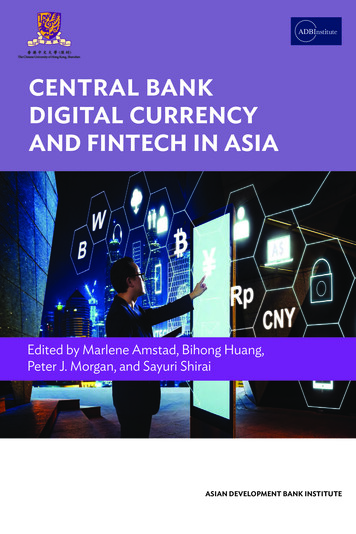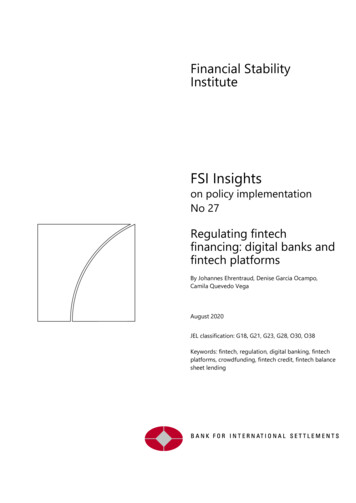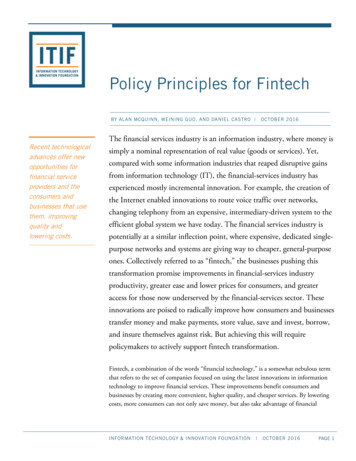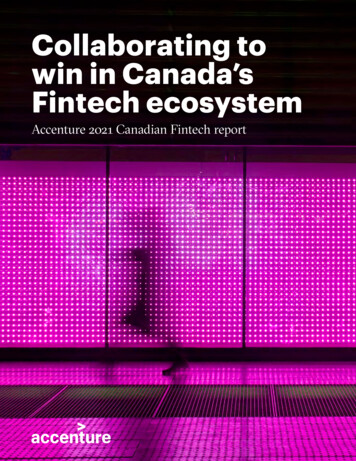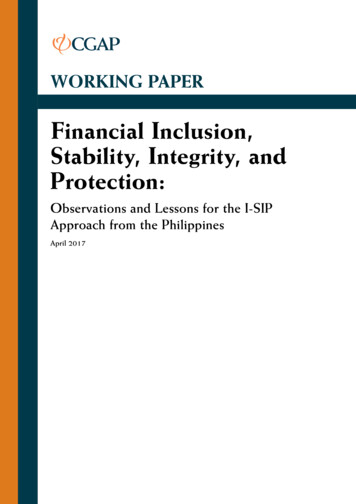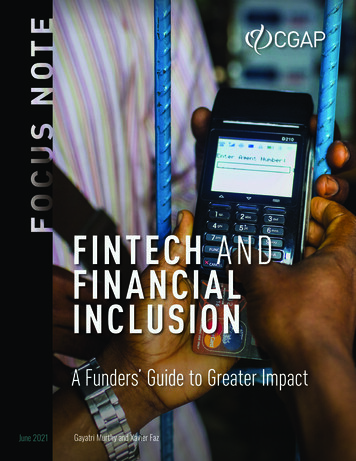
Transcription
FINTECH ANDFINANCIALINCLUSIONA Funders’ Guide to Greater ImpactJune 2021Gayatri Murthy and Xavier Faz
AcknowledgmentsThe authors would like to thank CGAP colleagues Jayshree Venkatesan, Faith Biegon, and PeterZetterli for their research, analysis, and several of the ideas presented in this paper. We are alsograteful to our CGAP colleagues Estelle Lahaye, Michel Hanouch, and Greta Bull for their insights,guidance, and contributions. Thanks to Vikas Raj of Accion Venture Labs for reviewing this FocusNote, and Andrew Johnson and Natalie Greenberg for their editorial support.Consultative Group to Assist the Poor1818 H Street NW, MSN F3K-306Washington, DC 20433 USAInternet: www.cgap.orgEmail: cgap@worldbank.orgTelephone: 1 202 473 9594Cover photo by Temilade Adelaja via Communication for Development Ltd. CGAP/World Bank, 2021RIGHTS AND PERMISSIONSThis work is available under the Creative Commons Attribution 4.0 International Public 0/). Under the Creative Commons Attributionlicense, you are free to copy, distribute, transmit, and adapt this work, including for commercialpurposes, under the terms of this license.Attribution—Cite the work as follows: Murthy, Gayatri, and Xavier Faz. 2021. “Fintech andFinancial Inclusion: A Funders’ Guide to Greater Impact.” Focus Note. Washington, D.C.: CGAP.Translations – If you create a translation of this work, add the following disclaimer along withthe attribution: This translation was not created by CGAP/World Bank and should not beconsidered an official translation. CGAP/World Bank shall not be liable for any content or errorin this translation.Adaptations – If you create an adaptation of this work, please add the following disclaimer alongwith the attribution: This is an adaptation of an original work by CGAP/World Bank. Views andopinions expressed in the adaptation are the sole responsibility of the author or authors of theadaptation and are not endorsed by CGAP/World Bank.All queries on rights and licenses should be addressed to CGAP Publications, 1818 H Street,NW, MSN F3K-306, Washington, DC 20433 USA; e-mail: cgap@worldbank.org.
CONTENTSExecutive Summary1Introduction3Section 1. Assessing and managing impact potential8Section 2. Funding strategically17Section 3. Influencing the market21Conclusion26Appendix A. Fintech and financial inclusion: an innovation map27Appendix B. Fintechs and underserved segments36Appendix C. Methodology39Appendix D. List of country interviewees40References42
1EXECUTIVE SUMMARYWHAT WILL BE THE NEXT BIG FINTECH INNOVATION INfinancial inclusion? Many donors and impact investors today are lookingto support new innovations to maximize their development impact. Butwith fintechs emerging all the time — many touting their potential to improve the livesof low-income, excluded customers with unproven business models — it is importantfor funders to be wary of hype and conduct due diligence in making investments anddesigning development programs.There are measures that development funders can take to identify fintech solutions withthe greatest potential and to structure their support in ways that help fintechs addresscommon challenges: Assessing and managing impact potential. Each stage of the fintech lifecycle –early, growth, and mature – is associated with different impacts and risks. Developmentfunders should carefully consider the type of impact they hope to achieve, as wellas their risk tolerance, and then focus their support at the appropriate stage(s). Forexample, by focusing on early-stage fintechs, funders can help identify and nurturesolutions that may one day be transformative for millions of people; however, this is notthe stage to look for scale or sustainability.Potential impact goals at different stages of fintech developmentAddresses a marketgap for excluded groups,but not fully sustainableor scaled yetEarly StageMeasurable growthin use without creatingconsumer risks ormarket distortionsGrowth StageSustainability andmeasurable positivecustomer outcomes(e.g., assets, capabilities,productivity, etc.).Mature StageIn assessing and measuring impact potential at any stage, development funders shouldconsider whether a fintech solution improves on existing solutions for low-incomecustomers in terms of cost, accessibility, product fit, or user experience. Measurableindicators can be developed within each of these categories. Funders of more maturefintechs may broaden their frameworks to assess other impacts on customers.E x ecuti v e Summary
2 Funding strategically. Fintech funding should be structured to expand responsibleinnovation, facilitate learning in the market, and attract additional support fromcommercial and local investors. Fintechs at different stages of development benefit fromdifferent types of support. For instance, funding local incubators and providing technicalassistance to early-stage companies can be effective ways to refine emerging businessmodels. On the other end of the spectrum, grants or equity investments can help moremature companies deepen and generate evidence of impact on low-income customers. Influencing the market. Without the right ecosystem, fintechs cannot growsustainably or reach low-income, underserved groups at scale. Unlike private investors,development funders are uniquely positioned to help build infrastructure, create aregulatory environment, and promote a capital ecosystem that enables promisingfintechs to reach their full potential. Funders also have an important role to play insharing impact evidence with each other and standardizing impact metrics.Not every development funder can engage with fintechs at all stages or support all aspectsof a thriving fintech ecosystem. Large organizations may have a more diversified approach,while others may be better off focusing on one type of investment, such as early-stageimpact investing. However, every development funder can have a meaningful impact byfunding strategically, sharing lessons learned, and working toward standard impact metrics.FINTECH A ND FIN A NCI A L INCLUSION
3INTRODUCTIONAS FINTECHS PROLIFERATE IN EMERGING MARKETS ANDdeveloping economies (EMDEs), they often target underserved customers withinnovative, technologically-enabled financial services, applications, processes,and products. These innovations are of growing interest to international developmentorganizations, including donors and impactinvestors. Many development funders haveWhat do we mean by “fintech”?witnessed the scale and impact of previousfintech innovations, such as mobile moneyThe term “fintech” lacks a universally acceptedin East Africa and platform-based financialdefinition. To reflect the way it is often used byservices in China and Southeast Asia. Theyfunders, this paper generally employs fintech tonow are looking for ways to support themean the use of technology-based innovation infinancial services. We refer to technology-basedlatest fintech innovations and maximize theirstartups developing and bringing these innovationspotential to impact the lives of underservedto the market as fintechs.low-income individuals.While a great deal of hype exists aroundfintech, including sweeping assertions ofits impact on financial inclusion, there aregenuine reasons for development fundersWhat do we mean by “development funder”?to be excited about recent innovationsWe use the term “development funder” in this paperin technology-enabled financial services.to denote organizations that provide funds—eitherEarlier CGAP research based on pilots withas grants, investment, or debt—to those seeking to18 startups found initial evidence that someachieve development goals. This includes donors,fintech business models have the potentialfoundations, development finance institutions (DFIs),to solve specific barriers to reachingdevelopment agencies, and impact investors.low-income populations with financialservices. For example, some fintechs offersmartphone-based payments apps with low data costs and storage requirements thatfacilitate use by segments with lower literacy. This reduces account dormancy and createsadditional use cases for payments. Others use satellite data and machine learning toexpand smallholder farmers’ access to crop insurance and increase their resilience (Murthyet al. 2019).CGAP’s earlier research also suggests that development funders, alongside policy makersand other stakeholders, have an important role to play in helping these and other promisingfintech innovations to reach the market and improve people’s lives.IN T RODUC T ION
4Common challenges facing fintech todayGlobally, fintechs often face three interrelated challenges that development funders canhelp to address through strategic, coordinated investments:(i) Inefficient market conditions. Without the right infrastructure, policies and regulatoryframeworks, and support from governments and civil society, fintechs cannot grow in a safeand sustainable way (Pazarbasioglu et al. 2020). India is a good example of how certainmarket conditions enable fintechs to thrive. Mobile technology, combined with the country’sinterconnected set of government-facilitated financial systems commonly referred to as theIndia Stack, has connected millions nationwide to the financial system and enabled a widearray of fintech business models to scale.1 In markets where this type of infrastructure andsupport does not exist, fintechs struggle to scale beyond the mosttech-savvy, urban, young, and affluent customers.“ For our business,the pace ofthe investor iseverything. Weprefer impactinvestors who canbe patient with ourslow-but-sure paceof growth.”(ii) Accessing capital at all growth stages. Fintech growthdepends on access to the right kind of capital—whether earlystage capital to prove the viability of a business model, growthcapital to achieve scale and sustainability, or debt finance tofund new credit portfolios. These different types of capital areoften missing in EMDEs or are accessible only to the mostwell-connected entrepreneurs. Fintechs describe funding as theirbiggest challenge, especially in the early and growth stages.(iii) Reaching and impacting poor customers. It takes timeeven for fintechs with the best of intentions to impact large numbersof low-income customers. When capital infusions come on the— Founder of an early-stagecondition of a quick return, it can be even more difficult for fintechslending company in Indiato be inclusive. In certain cases, the drive for profit can even lead toconsumer protection risks. Customer impact in an individual marketrarely depends on the rapid success of a single company but onthe emergence of a wide variety of firms serving several customer segments over time.Addressing challenges with a strategic,coordinated funding approachOver the past decade, both commercial investors and development funders in EMDEsincreasingly have invested in fintech. Funding directly and indirectly flows to the sector inmany ways, whether to support individual fintechs or to create an enabling environmentfor the fintech ecosystem through regulatory reform, infrastructure development, or marketresearch (see Figure 1).1India’s Aadhaar biometric identification system provides the foundation for an integrated set ofapplication programming interfaces (APIs). This “India Stack” manages secure user consent to sharedata, and it enables remote identification and authentication (e.g., eKYC for onboarding) for accountopenings and financial transactions.FINTECH A ND FIN A NCI A L INCLUSION
5FIGURE 1.Funding flows to fintechPrimaryFundersPrimary fundingDevelopment funders Public funders (e.g., DFIs, multilaterals,bilaterals) Private funders (e.g., foundations, social/impact investors, ommercial investors (e.g., financial institutions, angelinvestors, institutional investors)Incubators and acceleratorsFunds (VC, PE, impact, others)FintechMarketMarketecosystemFintechsThe amount of money invested in fintech has been on the rise in recent years. According toKPMG, global investment in fintech grew from 51 billion in 2014 to 135.7 billion in 2019(the COVID-19 pandemic slowed investment in 2020).2 However, little data exists on wheredevelopment funding is flowing relative to commercial funding—and the impact it may behaving. It is still unclear whether development funding complements commercial funding,builds a more conducive environment for commercial investors to enter, or enables fintechto reach low-income populations.Recent research from CGAP and MIX, a global data resource on the funding and impact ofinclusive financial services, has begun to shed light on these questions.3 Analysis of datafrom the world’s largest development funders and nearly 100 fintechs showsthat funding from both commercial investors and development funders targetsmature companies with proven business models. The fintechs overwhelmingly arepayment wallets and lenders, most likely because those products have been in the marketlonger and have a clearer pathway to profitability.Funding for more diverse or riskier innovations is more difficult to find (CB Insights 2019;Partech Africa 2020). Despite growing development funding, it is unclear whether related2 See KPMG International (2020). Figures are available for global commercial funding of fintech, but theyinclude China, developed countries in Europe, and the United States. Consolidated numbers for EMDEswhere development funders invest and engage are difficult to find.3 See: lopment-funders-supporting-inclusive-fintechsIN T RODUC T ION
6crowding-in of local or international commercial capital exists, especially in Africa. Whilemarkets like Indonesia already appear to be saturated by commercial investors, impactfocused, early-stage fintechs still struggle to find early funding. CGAP’s interviews withfintechs show that support beyond funding—such as access to capital markets andtechnical assistance—is still lacking, especially among early-stage fintechs.Development funders will need to pursue a coordinated, long-term approach to fill fundinggaps and better address the challenges fintech currently faces. The microfinance sectorstands as a useful example of how this can be achieved. Like fintech today, in its earlydays microfinance attracted a wide variety of commercial investors and developmentfunders. As the sector evolved, their approaches became more coordinated. Developmentfinance institutions (DFIs) boosted investor confidence through microfinance investmentvehicles (MIVs) and attracted more commercial and impact investors. This led to a periodof sustained growth that resulted in 17 billion worth of investments in microfinance in 2018alone (Symbiotics 2019). Further, donors supported development of standards and datareporting, and influenced financial regulations and financial inclusion policy in countries toformalize microfinance. Many countries now have regulatory frameworks that support theoperation of microfinance, and many MFIs have become licensed deposit-taking institutions.We see a similar opportunity in fintech today. Through coordinated action, certain marketgaps can be tackled: a lack of capital in Africa, market distortions in overcrowded Asianmarkets, lack of reliable information on impact, and, perhaps most crucially, insufficientsupport for early-stage innovation. Engagement with fintech companies sits outside thecore funding instruments of most development funders because fintechs are often toosmall and/or early stage. As a result, the impact of fintechs on poor people remains largelyhypothesized. The COVID-19 pandemic has demonstrated that the right digital innovationscan have a critical impact on poor people and increase their resilience to shocks (CCAF,World Bank Group, and WEF 2020), and many development funders are now looking forways to maximize fintech’s impact. It is an opportune time to recalibrate efforts.FINTECH A ND FIN A NCI A L INCLUSION
7Focus Note overviewThis Focus Note presents a vision for how development funders can support fintech inEMDEs to enable innovative business models that provide greater impact for poor people.It describes how development funders can structure investments and work toward acoordinated approach with other development funders. We offer guidance in three mainareas that would help address the challenges faced by fintechs, as previously outlined:1.Assessing and managing the impact potential of fintech investments2. Strategically funding to achieve impact and business potential3. Influencing the market to support an ecosystem of fintechs that serve low-incomecustomersGuidance presented in this paper is based on interviews with international donors,foundations, DFIs, and development agencies, as well as industry experts and researchers.We also conducted four country-level assessments of fintechs in India, Indonesia, Mexico,and Nigeria. Across these markets, CGAP interviewed 60 fintechs at different stages ofgrowth. We interviewed local investors and local representatives of development funders(both mature and early-stage investors, where possible), and other ecosystem stakeholderssuch as incubators, accelerators, fintech associations, and industry bodies. All the researchfor this paper was conducted between 2018–2020. Although this paper primarily isintended for development funders seeking to maximize their impact in the fintech sector,incubators, accelerators, and commercial investors may also find it useful. Appendix Cprovides additional details about our methodology.IN T RODUC T ION
8SECTION 1ASSESSING AND MANAGINGIMPACT POTENTIALASSESSING THE BUSINESS POTENTIAL OF AN EARLY-STAGEfintech company can be challenging, and determining its potential impact on poorpeople is even more difficult. Funders should set impact goals that are suitable foreach stage of development (see Figure 2).FIGURE 2.Potential impact goals at different stages of fintech developmentAddresses a marketgap for excluded groups,but not fully sustainableor scaled yetEarly StageMeasurable growthin use without creatingconsumer risks ormarket distortionsGrowth StageSustainability andmeasurable positivecustomer outcomes(e.g., assets, capabilities,productivity, etc.).Mature StageA variety of impact frameworks exist to help impact investors, DFIs, and other developmentfunders identify and measure these potential impacts and risks.4 These tools are applicableto the wide range of goals and outcomes many development funders are working toward,such as the United Nations Sustainable Development Goals (SDGs), and environmental,social, and governance (ESG) principles in general. Most development funders incorporateone or more of these frameworks into their analysis of impact. However, most frameworkscenter on a single program, output, or investee’s success in reaching customers.CGAP’s recent work on the evidence and impact of financial inclusion points to the needfor a deeper theory of change and a more holistic view of impact (El-Zoghbi 2019). Ifdevelopment funders want to better understand and capture the impact of their fintechinvestments, they must adopt a theory of change that moves beyond the initial effects ofan investee’s financial services. Funders must look beyond how financial services4See Johnson and Lee 2013, IFC 2019, and GIIN 2019 frameworks.FINTECH A ND FIN A NCI A L INCLUSION
9expand access and use, toward deeper, longer term outcomes on people’sopportunity to fulfill their goals or resilience to shocks.Different types of development funders may have differing impact goals. Commercialinvestors often are more focused on financial returns but want to ensure that basic do-noharm criteria are fulfilled. DFIs and impact investors may look to fill key market gaps andmarket exclusions through their investments. Rather than funding individual fintechs,donors may choose to focus on enhancing the fintech ecosystem. However, if donors andinvestors can link their investments to the specific effects fintechs have on poor people, alevel of uniformity and rigor could be maintained across the industry.Even in a nascent industry like fintech, development funders should consider a long-termperspective on impact when assessing a potential investment and define impact indicatorsthat measure success across different growth stages of firms—and across their entire portfolio. Indicators should be flexible andsimple enough that they can apply to young, early-stage fintechs,but also measure the deeper impact of growing or maturingfintechs. For example, an indicator such as “use” could expandfrom initial registration and first use (e.g., loan application anddisbursement) to deepening use (on-time repayments, repeatloans, growing deposits, etc.) to sustained customer relationships—Impact investor, India(customer relationship tenure, customer referrals, etc.).“ Impact is only anassessment metricin most deals.It needs to go deeperthan that.”Impact and risks at different fintech stagesThere is a general understanding that a fintech company’s lifecycle moves across threestages: from early, to growth, and then to maturity (see Figure 3).5 Development fundersshould carefully consider the type of impact they hope to achieve and tailor their efforts onthe appropriate stage(s).E A R LY-S TA G E I M PA C TIdentifying solutions that address market gaps for excluded groupsA wide range of early-stage fintech models offer exciting possibilities, but many do not survive.Rarely do the survivors reach any kind of impact in the early years of operation, since they mayoften have to prioritize financial viability and scale over impact. Venture capital plays a key role,not only to develop a business that produces certain financial returns, but also investing inhelping firms develop their impact potential. Venture capital, however, is often difficult to find inless developed markets. Yet funding fintechs at the early stage is important because it enablesthe launch of business models that may impact development. Experimentation carried out byearly-stage businesses also reveals important lessons for markets about what works and whatdoes not. These insights can benefit the industry at large.5 More complex classifications exist across investment rounds (Series A, B, etc.) and type of capital (debt,equity, venture capital, etc.), but a split like this is an entry point into those distinctions.A S SE S SING A ND M A N A GING IMPA C T P O T EN T I A L
10FIGURE 3.Assessing the impact potential of fintech through business model stagesDevelopmentstageEarly Stage(Seed or Series A)Growth Stage(Series B and C)Mature Stage(Series D orhigher)Impact goalThe fintechaddresses amarket gap forexcluded groupsThe fintech andothers like itcan reach scalewithout posingconsumerprotection risks.The fintech andothers like it aresustainable andcan demonstratepositive customeroutcomes withexcluded groups.ExampleA savings appoffers simplefeatures forplatform workersto save andmanage theirincome60% ofcustomerstake less thana minute todeposit into theiraccounts and twothirds conductmore than 3transactions permonth.30% ofcustomersincrease theirbalance over ayear. The appshares data forcredit scoringpurposes, butenables feature torequest customerconsent.5% of customersused savings topurchase newassets for theirbusiness. 6%used savings topay for a healthemergency,and 50% usedsavings fordaily householdexpenses.Most early-stage fintechs claim to bring new solutions to an existing customer problem. Insome instances they focus on traditionally excluded groups. In the four countries CGAPresearched, early-stage business models generally shared the following characteristics: Experimentation with new forms of scoring or underwriting for credit products, such asusing satellite data for agri-insurance, value chain analysis for micro and small enterprise(MSE) loans, and tracking savings group transactions for consumer loans. Introduction of new features and delivery mechanisms for conventional products,especially those aimed at serving excluded segments. Balance between digital and in-person customer interaction, especially by creating theon-the-ground partnerships that are key to serving excluded segments with complexproducts.In Nigeria, PiggyVest is an example of an early-stage fintech that brings savings andinvestments to a segment typically excluded from wealth creation opportunities. Itsinnovative use of an intuitive app and easy-to-use features help customers create savings orinvestment wallets differentiated by goals or risk. A similar model has scaled considerablyin the United States, but this type of fintech business model is still finding its feet in marketslike Nigeria where banking penetration is much lower.Another example of an early-stage model is Toffee, an innovative insurance delivery fintechin India that acts a bridge between low-income customers who may be new to insuranceand traditional insurance companies. The company provides simple insurance policiesFINTECH A ND FIN A NCI A L INCLUSION
11to protect customers against the risks most relevant to them, such as dengue, malaria,hospital cash, bicycle damage, and theft. Simplified sign-up processes on a mobileapp and at the point of sale expedite easy access. See Appendix A and Appendix B foradditional examples.Given the nascency of their business models, development funders should pick impactindicators that reveal how early-stage firms can solve a market gap for excluded groups.The focus of this stage is that fintechs develops services that satisfies a clearmarket demand by excluded and underserved segments. In contrast with existingsolutions, these services can show gains in cost, accessibility, fit and/or experience, all ofwhich can make financial services work better for low-income users (see Figure 4).The four criteria of impact in this framework apply to fintechs at all stages. As fintechsmature they must also have deeper impact on the market and their customers’ lives- wewill describe these deeper impacts in the next sections. But at the minimum, they mustexcel in one of these areas of customer value.Early-stage fintechs have the potential to create multiple effects. For instance, a fintechthat has figured out how to reduce the cost of offering agricultural insurance to smallholderfarmers concurrently may expand access. The sample scorecard in Box 1 may be useful todevelopment funders looking to assess impact of an early-stage fintech.FIGURE 4.Measurable ways fintechs at every stage of growth can impact poor peopleCostAccessFitExperienceMakes servicesmore afforableMakes financialservices moreaccessibleMakes financial services bettersuited to the needs and wantsof underserved customersOffers an improveduser experienceLowers operating costsExpands eligibility throughinnovative means of CDDMakes financial services bettersuited to the needs and wants ofunderserved customersHas product features that areeasier to access, understand,and compareLowers end user feesExpands eligibility throughinnovative means of riskassessmentAddresses a customer need notserved by typical productsHas an interface easier formost customers to understandand useOffers more flexible paymentsRequires less interaction atphysical transaction pointsAligns better with the need andwants of underserved customersDelivers clearer value to usersReduces the need forexpensive devicesExpands or improves thedistribution of physicaltransaction pointsAllows greater customization todifferent contexts, user needs, andpreferencesHelps users identify,understand, and resolveproblemsRequires less or cheaperconnectivityHas a higher degree of suitabilityfor target customersGives users control over dataReduces the need for collateralEnjoys higher general trust andsatisfaction from usersStronger technical securityA S SE S SING A ND M A N A GING IMPA C T P O T EN T I A L
12BOX 1.Sample scorecard to assess the impact of an early-stage fintechTo develop an early-stage fintech impact scorecard, development funders can definemeasures that have potential for marginal, low, moderate, and high impact upon thefour criteria in the fintech impact framework: cost, access, fit, and experience.Sample scoring criteriaMarginalimpactLow impactModerate impactHigh impactCostNo impact 10% costreduction10–30% cost reduction 40% costreductionAccessNo impactSome increase inaccess for existingsegmentsLarge increase inaccess to existingsegments; someincrease for excludedgroupsIncreasedaccess forboth existingand excludedsegmentsFitNo impactAddresses aproblem felt by aspecific lowincome segment,with low levels ofuptake among itAddresses a problemfelt by a specific lowincome segment, withmoderate levels ofuptake among itAddresses aproblem felt by aspecific lowincome segment,with high levels ofuptake among itExperienceNegativenet promoterscoreNet promoter scorebelow XNet promoter scorebetween X and YNet promoterscore above YOther metrics may be more suitable. Experience could also be measured bysuccessful transactions and quality of complaint resolution.Sample impact assessment scorecard performed for Übank, a Mexican fintechÜbank is a white label personal finance automation API for banks and financialinstitutions that helps people automate savings based on their lifestyle andeveryday expenses.Prospective impact scoreRationaleCostMarginalBased on existing bank account infrastructure,does not impactAccessLowImproves access to savings for existing bankingFitModerateEmbeds savings practices common tomany customers in low-income segments.Additionally, enhances women’s ability to savein a private wayExperienceHighExperience draws excitement in saving, netpromoter score (NPS) expected highcustomers(Continued on next page)FINTECH A ND FIN A NCI A L INCLUSION
13BOX 1. ample scorecard to assess the impact of an early-stage fintechS(continued)Visual representation of an impact scorecardDe
Fintech funding should be structured to expand responsible innovation, facilitate learning in the market, and attract additional support from commercial and local investors. Fintechs at different stages of development benefit from different types of support. For i
